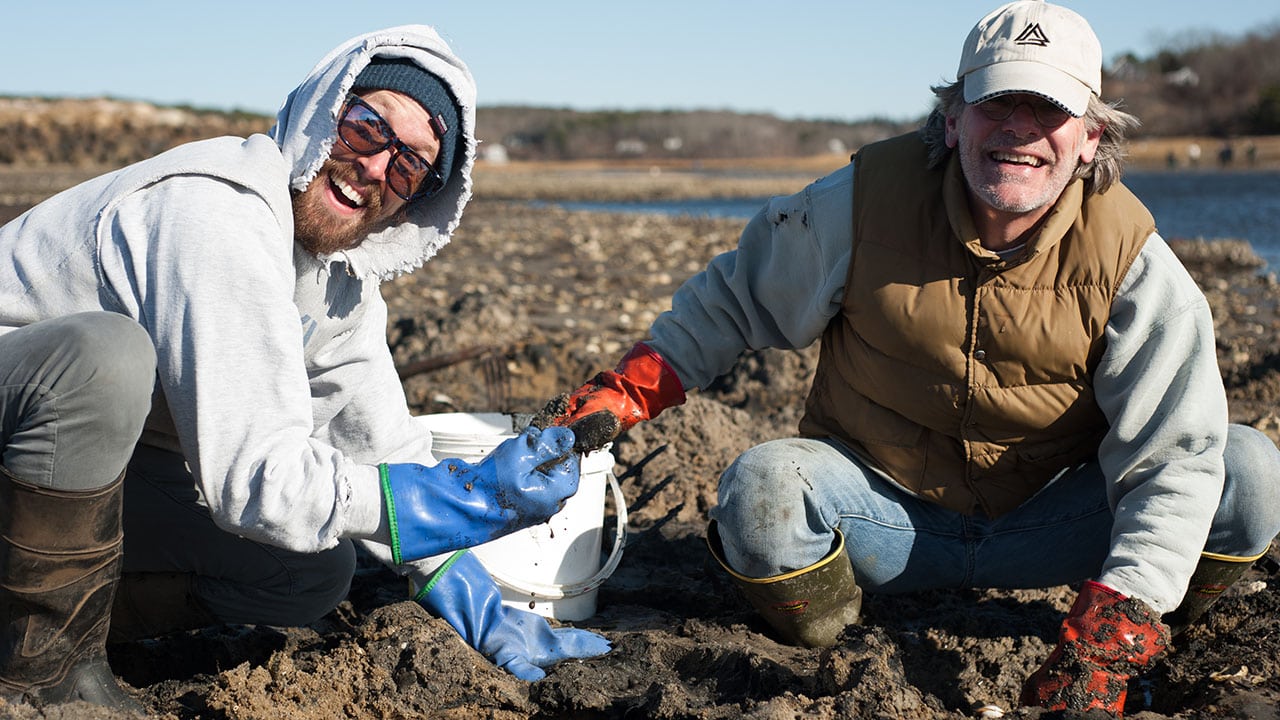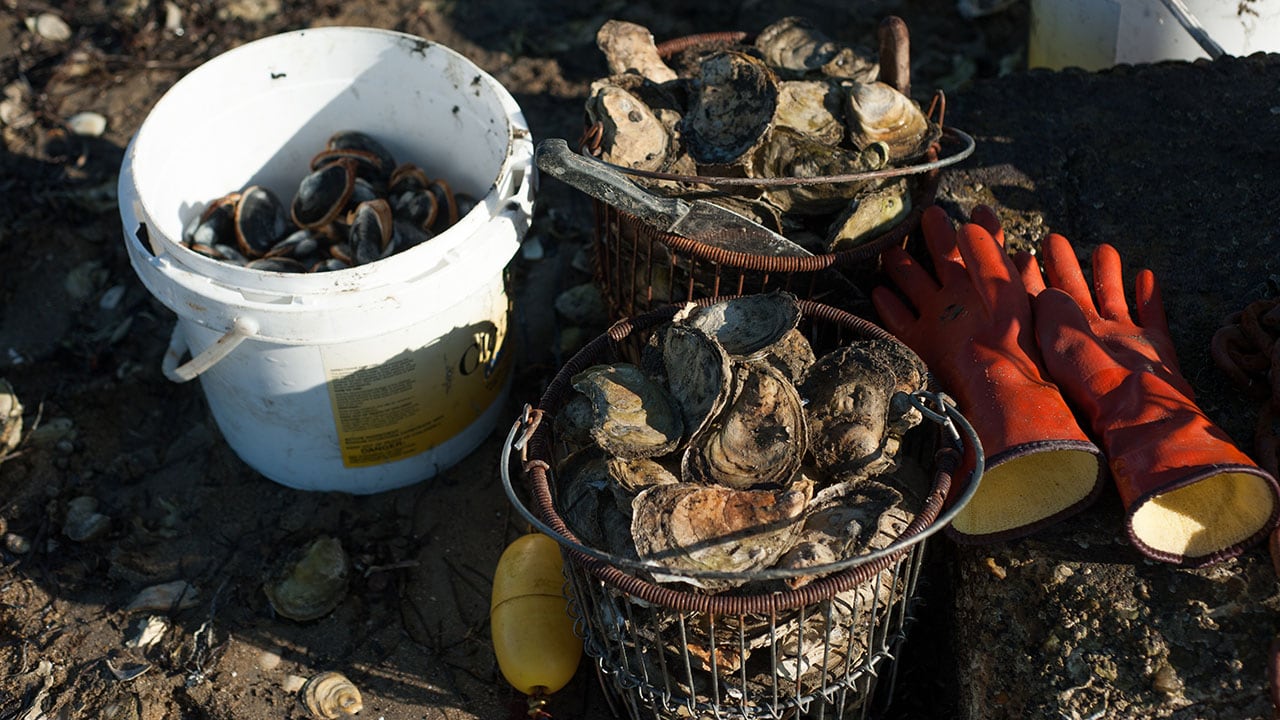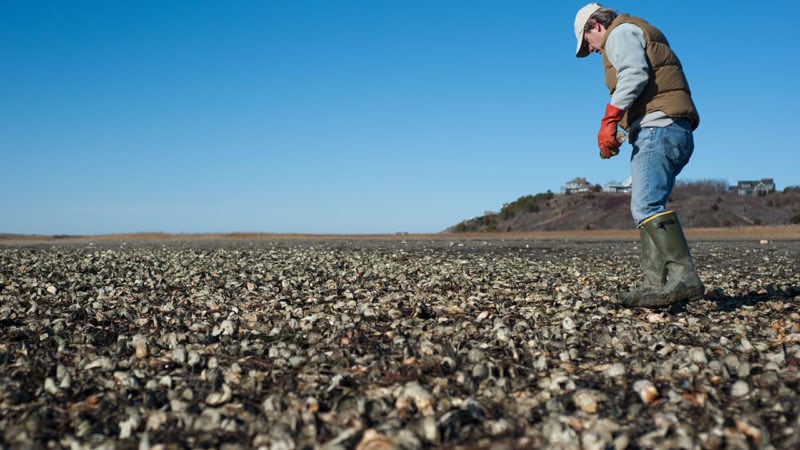Last Updated on December 22, 2020
It’s 7 am on a cold Sunday in January, and my father, Tom Littauer, is already up.
I hear him loading the bed of his pickup with wire baskets, rubber wading boots, and blunt, beat-up kitchen knives. I roll out of bed, bleary-eyed, and stumble downstairs. He hands me a banana and a mug of steaming coffee, and we hit the road.
Our destination? Oysters, straight from the ocean.
It’s a two-hour drive to Truro, MA—a vacation town near the tip of Cape Cod—and the road is absent of the clogging summer beach traffic. Dad’s excitement is contagious. He’s been making this journey every other Sunday in winter for over ten years, and yet every time I join him, it feels like we’re embarking on a grand adventure for the first time. We crack jokes, tell stories, and pass the time. I double-check the tides, but I don’t need to. We’re set to arrive right at low tide. As always, Dad’s got it all dialed in.
We park outside of Truro Harbor. “This is not the Kentucky Derby,” Dad says, tossing me a pair of thick rubber boots and his old Naval Academy sweatshirt. “It’s important to have the disheveled oyster look. We’re becoming one with low tide and nature, and it’s going to get mucky.” We layer up in our Sunday worst, pick up rakes and knives, wire baskets and clam buckets, and march out to the oyster bed.

Oysters of all shapes and sizes cover the mucky sand. They grow on top of each other in tight clusters, and we use the blunt knives to carefully pry off the ones that are three inches or larger, the legal limit.
“When I first started,” Dad tells me, “I would just pick up any oyster three inches or longer. But if you watch the seasoned guys, they look for the oysters with deep bowls, because those, when you shuck them, hold all the oyster liquor in the shell. Those are the most desirable.”
The local harbormaster is there on the flats with us, greeting regulars by name and checking permits. The season is only open on Sundays between November and March, and the town sells a limited number of permits each year. Oyster beds are a precious resource, instrumental in maintaining water purity. A single oyster can filter up to 30 gallons of water a day.
We layer the oysters in our wire baskets, bowl-side down so they don’t leak out that precious oyster liquor. Before long, our baskets are full—and we move on to the clams. Dad scouts out patches of sand that have the telltale breathing holes, and we start digging. A foot down, we find clusters of brittle-shelled steamers and the rounder, fatter quahogs.
“Back in the sixties, I would dig for quahogs on Long Island Sound with your great grandfather, Grandpa Williams,” he tells me as he reaches up to his elbow in the muck to retrieve a clam the size of a tennis ball. “I was 9-years-old, the perfect age. It was like a giant Easter egg hunt in the ocean.”
That child-like joy is still there in my father—in his grin and the eagerness of his digging. I find myself grinning, too, even as my arms and back begin to ache. I’m out here with my father, doing what he did as a kid. This mucky tradition is now four generations old.
The sun is shining and it’s a balmy 35 degrees, but it’s not always this pleasant. “If it’s blowing hard, it can get really cold,” he says. “You can get stuck in the muck, it’s almost like quick mud. And the shells are really sharp. They can slice your gloves and boots and fill them with water. When you’re wet and freezing, and you get trapped in the mud in the dead of winter and the tides coming in, it can give you a nasty wake up call.”
As if it’s listening, the tide creeps up on us, and we decide to call it a day. We make the quarter-mile trek back to the truck, a basket of oysters in one hand, a bucket of clams in the other. The buckets are heavy, and our shoulders are screaming by the time we reach the truck. On the way back, we stop by our favorite joint for a well-earned tradition—bagel sandwiches, packed with smoked salmon, cream cheese, and capers.

Once home, we rinse and evaluate the bounty. Between the two of us, there are around 150 oysters, and easily as many clams. Dad layers them into a cooler and props the top to let the oysters breathe. If kept around 40 degrees, the oysters will stay alive and fresh for over two weeks. During that time, Dad will have neighbors over to share oysters, and drop shellfish care packages at the houses of friends. “It’s very well-received,” he says, laughing.
Our celebration comes at dinner. Dad pulls out a shucking knife and gets to it. There’s an art to prying the shells open, keeping the juice in the bowl and keeping bits of sand and shell out of the meat. We take turns shucking, bantering about which of us does it better. I do, of course. We top them off with a homemade mignonette—Dad’s special recipe—and then we feast. “They don’t get any fresher than this,” he says. “You can’t buy oysters this good!” As if to prove the point, he does a ridiculous little jig around the kitchen, his famous “oyster dance.”
The raw oysters are just the appetizer. Dad, a long time ButcherBox member, pulls out a thick sirloin cap. “I marinate it in Yankel’s marinade,” he says. “It’s unbelievable.” He lets it come to room temperature before crosshatching the fat cap and tossing it on the grill, cooking it until it’s medium-rare.
We linger around the table long after the food is gone, reluctant to let the experience end. But like all things, it can’t last forever. The next day, we part ways, and I head back to my life in the city.
I can’t join him every time he goes, but I go as often as I can. Every time is the same—I’m a kid again, going exploring with Dad. The food is incredible, but it’s only a part of the experience.
The real treat is being able to share it all with my father.
All images are the work of Natalia Boltukhova.



